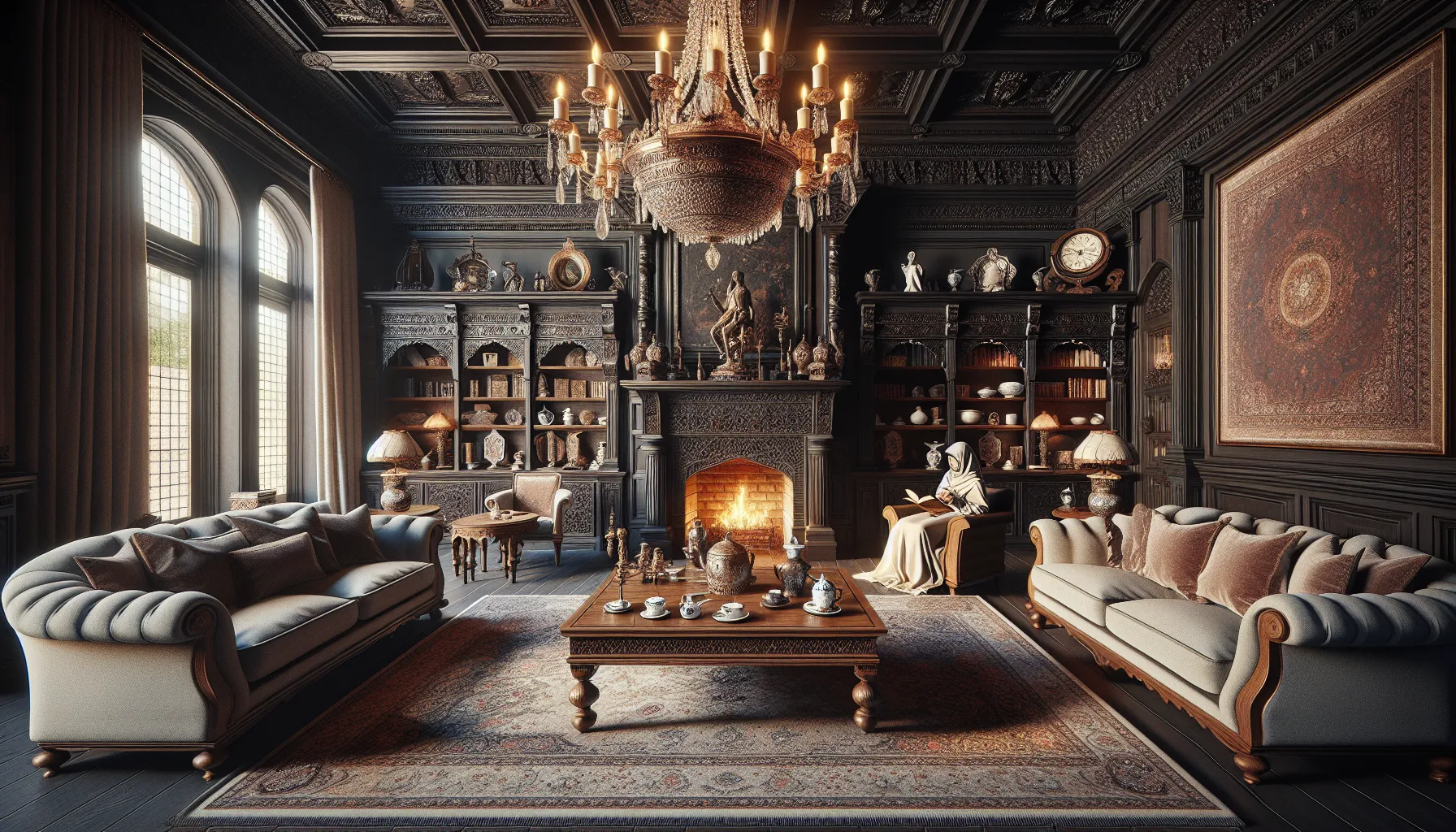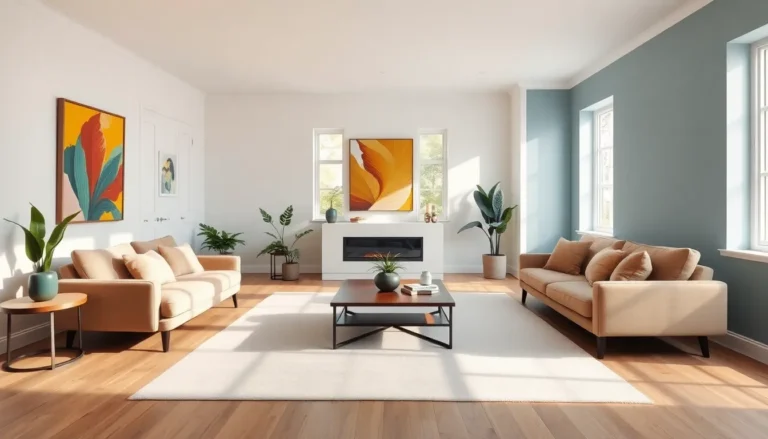In a world dominated by sleek modern designs and open-concept layouts, traditional living rooms stand as a cozy refuge, inviting warmth and nostalgia. Imagine sinking into a plush armchair, surrounded by rich wood finishes, elegant drapery, and a fireplace crackling softly in the background. It’s like stepping into a time machine where comfort reigns supreme and every corner tells a story.
Table of Contents
ToggleOverview of Traditional Living Rooms
Traditional living rooms embody timeless elegance and comfort. These spaces often feature classic architectural details that create a sense of warmth and familiarity. Rich wood finishes, such as mahogany or cherry, dominate furniture and cabinetry, enhancing the room’s sophistication.
Soft, inviting color palettes include creams, taupes, and deep jewel tones, lending an air of calmness. Draperies made from luxurious fabrics like silk or velvet hang from ornate rods, framing windows while providing control over natural light. A warm fireplace typically serves as the focal point, drawing family and friends together during cooler months.
Traditional living rooms often showcase handwoven rugs that add texture and softness underfoot. Accent pieces, such as antique furniture, art, and family heirlooms, tell a story and reflect personal history. Decorative lighting fixtures, including chandeliers and sconces, illuminate the space, adding to its charm.
Seating arrangements are strategically designed for conversation and relaxation. Plush sofas and wingback chairs invite guests to linger, allowing for meaningful interactions. Coffee tables often center pieces, providing space for books, magazines, and decorative trays.
Nostalgia plays a significant role in these living spaces. They invoke memories of gatherings and storytelling, creating an atmosphere that feels both personal and welcoming. Traditional living rooms remain cherished by those who appreciate their beauty, inviting others to experience a space that transcends time.
Key Characteristics of Traditional Living Rooms
Traditional living rooms exhibit a cozy, inviting atmosphere, reflecting timeless design principles. These spaces often emphasize comfort and familiarity through their features.
Color Palettes
Soft color palettes dominate traditional living rooms. Creams, taupes, and deep jewel tones create a calming environment. Warm earth tones blend seamlessly with rich wood finishes. Contrast enhances the sophistication of space. Accent walls in muted colors add depth without overwhelming. Together, these hues foster a sense of tranquility and warmth.
Furniture Choices
Furniture selections prioritize comfort and elegance. Plush sofas adorned with sumptuous fabrics encourage relaxation. Wingback chairs add classic charm and offer inviting seating options. Antique pieces tell a story, showcasing personality and history. End tables crafted from rich woods enhance the overall aesthetic. Together, these choices establish a welcoming setting for gatherings.
Decorative Elements
Decorative elements breathe life into traditional living rooms. Luxurious draperies frame windows while allowing natural light to filter in softly. Handwoven rugs introduce texture and warmth underfoot. Family heirlooms adorn shelves, reinforcing personal connections. Artwork featuring classic themes evokes nostalgia, enriching the ambiance. Each element contributes to an environment that resonates with comfort and charm.
Popular Styles of Traditional Living Rooms
Traditional living rooms encompass several distinct styles, each offering unique charm and character.
Colonial Style
Colonial style living rooms highlight symmetry and simplicity. Wooden beams frequently adorn the ceilings, enhancing historical authenticity. Furniture pieces often include simplistic designs with straight lines. Rich colors like navy, deep red, and hunter green create a warm environment. Decorative elements feature American antiques, showcasing a blend of practicality and elegance. Textiles usually include patterned fabrics in durable materials. The overall aesthetic fosters a sense of history, inviting relaxation while celebrating early American culture.
Victorian Style
Victorian style living rooms exhibit ornate details and rich fabrics. Heavy draperies accentuate windows, often featuring luxurious patterns and textures. Furniture choices lean towards dark woods, often intricately carved. Tapestries and floral patterns are common in upholstery, creating a lavish feel. Accessories include vintage items, such as oil lamps or ornate mirrors. Overstuffed sofas encourage comfort, while decorative elements like porcelain and glass figurines add personality. These rooms exude opulence, making them inviting spaces for gathering and storytelling.
Farmhouse Style
Farmhouse style living rooms embrace rustic charm with a cozy atmosphere. Natural wood elements, like exposed beams and shiplap walls, enhance the design. Neutral color palettes, often in whites and creams, generate a serene environment. Comfortable seating, including overstuffed couches and vintage chairs, invites family and friends to relax. Simple textiles, such as linen and burlap, contribute to the overall aesthetic. Accessories often feature handmade or vintage items, celebrating craftsmanship and personal history. This style resonates with warmth, creating a welcoming space for connections.
Tips for Designing a Traditional Living Room
Designing a traditional living room requires careful attention to detail and a commitment to comfort and elegance. Focus on creating a space that reflects timeless design principles.
Choosing the Right Furniture
Select furniture pieces that exude comfort and elegance. Plush sofas with classic lines work wonderfully alongside wingback chairs, inviting guests to relax. Incorporate antique items that tell a story, such as a vintage coffee table or a beautifully crafted sideboard. Rich fabrics, like velvet or damask, enhance the luxurious feel of the room. Opt for wood finishes, such as mahogany or oak, to add warmth and sophistication. Grouping seating arrangements encourages conversation, fostering an inviting atmosphere that brings people together.
Incorporating Accessories
Accessory choices play a vital role in enhancing a traditional living room. Utilize luxurious draperies to frame windows and impart a sense of grandeur. Position handwoven rugs strategically to introduce texture and warmth underfoot. Embrace the use of family heirlooms, showcasing personal history through thoughtful displays. Incorporate decorative accents, such as ornate mirrors or vintage lamps, to add charm. Sculptural elements, like vases filled with fresh flowers, can also inject life into the space. Create a layered ambiance by balancing large pieces with smaller decorative items, ensuring a cohesive look throughout the room.
Traditional living rooms continue to capture hearts with their unique blend of elegance and comfort. These spaces invite relaxation and connection through thoughtful design elements that evoke nostalgia. By incorporating rich wood finishes, soft color palettes, and personal heirlooms, anyone can create an inviting atmosphere that feels both timeless and personal.
The charm of traditional living rooms lies in their ability to foster relationships and create lasting memories. As trends evolve, the allure of these classic spaces remains steadfast, making them a cherished choice for those seeking warmth and sophistication in their homes. Embracing traditional design principles not only enhances aesthetic appeal but also nurtures a sense of belonging and comfort.




